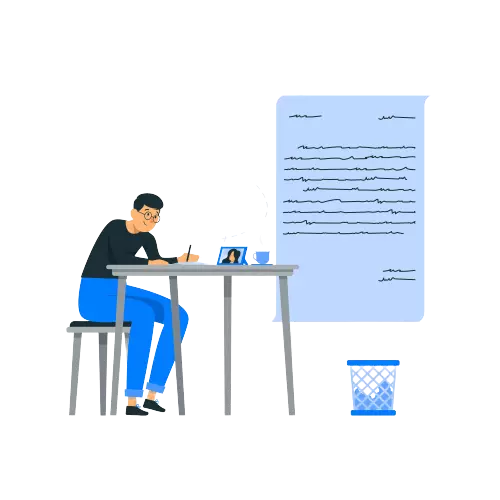Using ChatGPT to Write an Introduction
Published by at October 2nd, 2023 , Revised On January 15, 2025
We live in the age of artificial intelligence, where we find many AI writing tools at our fingertips, enabling us to improve and streamline our content production. One of the most notable advancements is ChatGPT by OpenAI. The beauty of ChatGPT lies in its conversational abilities and ability to assist in content creation, including the daunting task of crafting a compelling introduction. Here is how.
Why is an Introduction Important?
Before we dive into the mechanics of using ChatGPT, it’s essential to understand the importance of an introduction. The introduction serves as the gateway to your content, setting the tone, establishing context, and, most importantly, grabbing the reader’s attention. A well-written introduction can be the difference between a reader continuing with enthusiasm or abandoning the content entirely.
The Power of ChatGPT
GPT (Generative Pre-trained Transformer) is a revolutionary artificial intelligence model developed by OpenAI. ChatGPT, based on this model, is capable of understanding context, generating coherent responses, and producing high-quality written content across diverse subjects. Some might consider it one of the best AI writing tools available, and others might see it as a step closer to fulfilling the vision of the CEO of ChatGPT. While the tool cannot replace the intuition and creativity of human writers, it certainly offers significant advantages:
- Speed: Within seconds, ChatGPT can generate a coherent and well-structured introduction, saving time in the initial drafting phase.
- Flexibility: Whether you need an introduction for a technical paper, a casual blog post, or a narrative story, ChatGPT can be guided to adapt its tone and style to your needs.
- Iteration: Unsure about the first draft? ChatGPT allows for quick iterations, offering different angles or perspectives on your topic.
Steps to Craft an Introduction with ChatGPT
Set Clear Intentions
Before seeking ChatGPT’s assistance or even discussing how to write an essay using ChatGPT, clarify your topic and the desired tone (e.g., formal, casual, humorous). For instance, if you are writing about ‘The Impacts of Climate Change,’ you may want a serious tone. However, a topic like ‘The Funniest Misadventures of My Travels’ could have a light-hearted approach.
Provide Context to ChatGPT
ChatGPT produces the best results when given detailed information. Start by feeding the tool with context.
For instance: “ChatGPT, I need an introduction for a blog post about the latest advancements in renewable energy. The tone should be optimistic and geared towards a general audience.”
Review and Iterate
Once ChatGPT provides an introduction, read it thoroughly. Does it align with your expectations? If not, refine your prompt or ask specific questions to guide the tool towards your desired output.
Personalise the Content
Remember, while ChatGPT is powerful and might be in the arsenal of many ChatGPT owners, it does not know your unique voice. After generating the introduction, tweak it to make sure it aligns with your style. Add personal anecdotes, insights, or any unique perspectives that make the content truly yours.
Feedback Loop
Use the introduction as a foundation. If you feel the content lacks depth or a particular angle, go back to the tool with more precise ChatGPT prompts.
For instance: “Can you provide a statistic about renewable energy to enhance the introduction?”
How to Use ChatGPT to Write an Introduction
Let’s dive deep into how you can maximise ChatGPT for different functions.
Writing an Introduction
An introduction serves as the foundation of any piece of writing, setting the tone and giving readers a taste of what’s to come. Crafting a compelling introduction can sometimes be daunting. With ChatGPT, you can alleviate this challenge by:
- Prompting with Purpose: Feed ChatGPT a concise version of what you want to convey. For example, “Introduce an article about the benefits of organic farming.”
- Iterative Refinement: Based on the initial response from the AI, you can refine and tweak until you’re satisfied. It’s a conversation – each piece of feedback helps in getting the desired output.
- Using Examples: Provide ChatGPT with examples of introductions you like, and specify what you’re aiming for. It can then generate something in a similar vein.
Writing an Introduction Outline
An outline helps to structure your thoughts and ensures that your introduction has all the necessary components. To use ChatGPT for creating an outline:
- Provide a Summary: Let the AI know the main topics or themes of your piece, and ask it to generate a basic outline for your introduction.
- Ask for Details: Request ChatGPT to elaborate on any of the points it suggests, ensuring you have a clear path to follow.
- Review and Reorder: Based on the output, you can rearrange or modify the points as you see fit. It’s an interactive way to mould the structure.
Summarising the Arguments
Summarising is an art. It’s about capturing the essence without losing the core message. Here is how ChatGPT can assist:
- Direct Summarisation: If you provide a block of text to ChatGPT and ask it to summarise, it will provide concise information.
- Iterative Summarisation: Sometimes, you might want multiple layers of summarisation, moving from a broad overview to more detailed summaries. By continuously refining your request, ChatGPT can provide these layered summaries.
- Highlight Key Points: Ask the AI to highlight or list the main points from a given text. This gives you both a summary and a reference list of important arguments.
Paraphrasing Text
Paraphrasing is essential for presenting information in a fresh manner or tailoring it for a specific audience. ChatGPT is adept at this:
- Direct Paraphrasing: Simply give a sentence or paragraph to ChatGPT and ask it to rephrase it.
- Specify Tone or Style: If you want the paraphrased content to have a particular tone (e.g., formal, casual, humorous), mention this in your request.
- Paraphrasing for Clarity: If there’s a complex piece of text that you are struggling with, ChatGPT can rephrase it for clarity, making it easier to understand.
Plain Text
Alcoholism has detrimental effects on the liver, a vital organ responsible for detoxifying the body. Chronic alcohol consumption overwhelms the liver’s ability to process alcohol, leading to fatty liver disease, characterized by fat accumulation in liver cells. This can progress to alcoholic hepatitis, an inflammation and cell death scenario causing symptoms like jaundice and fever. Continued abuse can lead to cirrhosis, where healthy liver tissue is replaced by scar tissue, severely impairing liver function. Cirrhosis can cause liver failure, a life-threatening condition. Moreover, alcoholics have a higher risk of liver cancer. Early intervention and abstaining from alcohol can reverse some damages, but advanced cirrhosis is often irreversible.
The academic papers we write have:
- Precision and Clarity
- Zero Plagiarism
- High-level Encryption
- Authentic Sources

Paraphrased Text Using ChatGPT
Chronic alcohol intake can severely damage the liver, an essential organ that cleanses the body of toxins. Prolonged drinking overloads the liver’s capacity to metabolize alcohol, resulting in fatty liver disease, where fat deposits build up in liver cells.
This can escalate to alcoholic hepatitis, which involves inflammation and cell death, leading to symptoms like yellowing of the skin and fever. If alcohol abuse continues, it can progress to cirrhosis, where healthy liver tissue turns into scar tissue, significantly hampering its function. Cirrhosis can culminate in liver failure, a fatal condition.
Furthermore, individuals who consume alcohol excessively face a heightened risk of liver cancer. While early intervention and quitting alcohol can heal certain damages, severe cirrhosis is typically permanent.
Generating Feedback
Feedback is invaluable in the writing process. While ChatGPT does not critique in the traditional human sense, it can offer insights:
- Comparative Feedback: Provide two versions of a text and ask which one is clearer or more engaging. ChatGPT can provide feedback based on linguistic structures and patterns it’s trained on.
- Grammar and Structure Review: Request the AI to review a piece of text for grammatical errors or structural inconsistencies.
- Suggest Improvements: Ask ChatGPT for suggestions on how to enhance a piece of writing. While it might not provide subjective critique, it can offer alternatives or improvements based on the vast amount of text it has been trained on.
Example
ChatGPT provided feedback on the paragraph on alcoholism’s effects on the liver.
Areas for Improvement:
- Repetitiveness: The terms “liver” and “alcohol” are used frequently, which might feel repetitive to the reader. This could be streamlined.
- Transition Phrases: The transitions between the stages of liver damage might be smoother with the addition of some transition words or phrases.
- Additional Context: Consider mentioning the broader systemic effects of liver damage. For example, how liver health influences overall well-being or other organs’ functioning.
- Source Citing: If this text is to be used in a formal or informative capacity, it may benefit from the inclusion of reputable sources or studies that back up the claims.
Example of Introduction Using ChatGPT
Influence of Technology on Modern Education
In the rapidly evolving landscape of the 21st century, few sectors remain untouched by the transformative hand of technology. Education, a cornerstone of societal development, stands at the forefront of this revolution.
From virtual classrooms to AI-driven personalized learning modules, technology is redefining the way we perceive and engage with educational paradigms. This article delves into the profound implications of this synergy between technology and education, unpacking its benefits, challenges, and the future it promises. Join us as we journey through the digital transformation that is reshaping the hallways of learning for generations to come.
Frequently Asked Questions
Table of Contents
An effective introduction grabs the reader’s attention, presents the topic, and states the main idea or thesis. Start with a hook—a quote, statistic, or anecdote. Then, briefly contextualise the topic, guiding readers into the subject. End by clearly stating the purpose or thesis, and setting the direction for the piece.
Utilise ChatGPT for academic writing by seeking topic explanations, generating content ideas, structuring arguments, or clarifying complex concepts. Ensure to fact-check any information provided. Avoid direct copy-pasting; instead, use insights as a foundation, ensuring your work maintains originality and adheres to academic integrity and referencing standards.
To craft an introduction with ChatGPT: present your topic, ask for relevant hooks or background data, and request a thesis statement. Combine the responses for a coherent start. Always refine the generated content to fit your specific audience and purpose, ensuring clarity and engagement in your introductory paragraph.
- Open with a relevant quote or anecdote.
- Pose a compelling question.
- Share a startling statistic or fact.
- Provide a brief narrative or personal story.
- Define a central term or concept. Each method should be tailored to fit the topic, setting the tone and context for readers.






